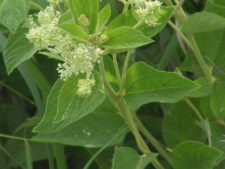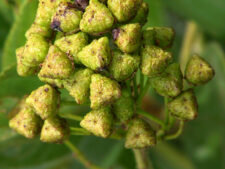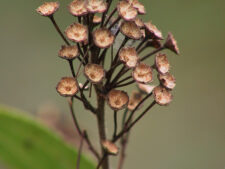
The woody stems of this 1-3 foot, much-branched, native tallgrass prairie shrub arise from deep reddish roots, the origin of one of its many common names. Finely toothed, alternate, oval-shaped leaves are 2-4 inches long (C). Dense rounded clusters (panicles) of tiny, white, 5-petaled flowers less than 1/8 inch wide are on long, leafless stalks originating at the junction of leaf and stem (leaf axil.)(B). The triangular, three-lobed brown fruit (D) splits into three parts when mature separating from its small, saucer-like base which may persist through the winter (E).
Prefers drier upland sites in our eastern Nebraska prairies. Two fairly robust plants were present in the early 2000’s in Knull Prairie, the Neale Woods prairie restoration site near the old Millard Observatory. It has not been seen recently and there are no other known occurrences at either NW or FF. Flowering occurs from May to July.
Native Americans used this plant extensively as a medicinal agent and a beverage. They likely passed this knowledge on to the colonists who used it in place of black tea during the Revolutionary War.
Eastern Nebraska’s native prairies are host to 2 very similar species of New Jersey Tea that are not easy to tell apart. The species described above, (Ceanothus americanus), has long flower stalks that arise from the junction of the leaf and stem (leaf axil) and broader leaves with a more rounded base. The other species which is the one most likely to be found in eastern Nebraska’s prairies (Ceanothus herbaceus) has narrower leaves which are more tapered at the base and smaller flower clusters that occur at the tips of this year’s new growth.
There are a number of common names for this shrub including Red Root, Wild Snowball, Snowbrush and Spangles.

 Identification
Identification


